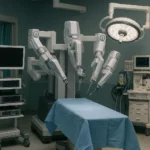Vision Loss Treatment in India with Advanced Therapies
For millions across the globe, vision impairment is no mere medical condition; it is a continuous uphill struggle that greatly influences independence, confidence, and quality of life. A gradual dimming of vision typically signifies conditions such as retinitis pigmentosa and age-related macular degeneration (AMD), with little or no chance of reversal. But science has given birth to a new dawn, bringing vision loss treatment to the forefront of medical advancements.
Cutting-edge breakthroughs in stem cell therapy, bionic eyes, gene editing and retinal implants are renewing hope where once there were none. These trailblasing therapies are starting to redefine ophthalmology, with the promise of restoring vision by targeting the very causes of photoreceptor cell vision loss, structural loss of retina and loss of the optic nerve.
Understanding Vision Loss and the Need for Vision Loss Treatment
A plethora of causes of vision loss exist, such as partial blindness or complete blindness. Additionally, damage may occur in various sections of the eye, with the retina, optic nerve, or photoreceptor cells almost always being involved. For instance, severe loss of vision can stem from retinitis pigmentosa – a genetic disorder in which the photoreceptors—the cells responsible for vision within the retina—come under gradual attack. As a result, night blindness, tunnel vision, and ultimate blindness are the three forms of vision restriction that develop in succession, in individuals with this disorder.
Others are AMD, diabetic retinopathy, glaucoma and damage to the optic nerve. Most conventional interventions either manage the symptoms or slow down the rate of degeneration. None, however can actually treat the underlying condition or reverse any damage done, particularly when photoreceptors or optic nerve tissues have been destroyed.
Stem Cell Therapy: A Breakthrough in Vision Loss Treatment
- Stem cell therapy activates undifferentiated cells to become specialised retinal cells.
- Embryonic stem cells and induced pluripotent stem cells (iPSCs) are being investigated for photoreceptor and retinal pigment epithelium (RPE) regeneration.
- Clinical trial results show promising outcomes, with patients receiving RPE grafts from stem cells showing partial vision restoration and improved visual acuity.
- The goal of therapy is to replace damaged retina cells with functional photoreceptor cells to restore light perception.
- Challenges include concerns over immune rejection and tumorigenesis.
- Potential remains high, and with advanced protocols and ethical sourcing, stem cell therapy may become a standard treatment for eye degenerative diseases.
Bionic Eyes: Merging Biology with Technology
- The concept of a bionic eye, once considered science fiction, is now a reality.
- A bionic eye typically includes a miniature camera in glasses, transmitting visual information to a chip implanted in the eye.
- The chip stimulates remaining retinal cells, sending signals to the brain via the optic nerve.
- The Argus II system is one of the first FDA-approved retinal implants, helping patients with retinitis pigmentosa perceive shapes, movement, and read large letters.
- Although resolution is limited, basic vision can change the lives of those who have lived in darkness.
- New advancements aim to improve resolution, reduce component size and incorporate AI-based image processing, enhancing both vision and environmental interpretation.
Photoreceptors and Retinal Implants: Targeting the Core
The majority of vision impairment is caused due to the death of photoreceptors. These are the rods and cones that are responsible for converting light into neural signals in the retina; their degeneration disturbs the entire visual cascade. Retinal implants seek to either directly replace or stimulate the lost cells.
Subretinal implants like PRIMA are implanted beneath the retina to restore phototransduction. These implants capture light, convert it into electrical impulses and directly stimulate two minds that relay these signals to the optic nerve. Such direct stimulation provides a more natural visual experience than the use of external apparatus.
Gene Editing: Correcting the Defect at Its Source
- Gene editing holds particular promise for inherited retinal diseases, particularly retinitis pigmentosa. Techniques such as CRISPR-Cas9 are being used to repair the defective genes responsible for degeneration. Instead of alleviating symptoms or replacing cells, gene editing attempts to act on the very source of the problem: the genetic mutation itself.
- Clinical trials for testing CRISPR therapies in the eye for safety and efficacy are ongoing. If successful, these treatments may provide long-lasting or even permanent cures for patients, by intervening with the degenerative process before it enacts irreversible destruction.
Optogenetics and Nanoparticles: New Frontiers in Vision Science
Two highly interesting and little-known fields are thereby making entry into the scientific limelight: i.e., optogenetics and nanoparticles. In optogenetics, scientists genetically modify surviving retinal cells so that they respond to light, thus converting these cells into surrogate photoreceptors at will. Such reprogrammed cells, when activated with the light emanating from special goggles designed to emit light at particular wavelengths, would assist patients to perceive movements, shapes and contrasts.
On the other hand, researchers evaluate nanoparticles as promising and analogous to light-to-electricity conversion, similar to how natural photoreceptor cells work. They might inject the particles into the eye, and preliminary tests have shown encouraging results in animal models. Their strength lies in their presumed non-invasive nature and compatibility with the existing retinal structures.
Restoring the Optic Nerve: The Final Frontier
Researchers have already achieved a great deal of advancement in regenerating retinal cells, but they still face the biggest challenge of restoring function in a damaged optic nerve. The optic nerve is the communication highway between the eye and the brain. It is extremely hard, if not impossible, to reconnect the optic nerve if it is severed or seriously damaged.
Still, encourages regenerative optic nerve fiber research in the using a combination of investigators trying stem cell-derived neurons with scaffolding material with gene-therapy or growth factor treatment. People are cautiously optimistic that even optic nerve damage may someday be reversible.
Merging Technologies: The Future Is Hybrid
It seems that the most possible way to go forward is by stacking various inventions. Picture a singular therapy wherein gene editing would cease the course of retinitis pigmentosa stem cell therapies self-regenerated lost photoreceptors leaving retinal implants to fill in the gaps of optogenetics reprogrammed remaining cells nanoparticles tune light processing.
This hybrid approach offers several ways of attacking vision loss. It increases the possibility of being able to restore normal vision successfully and long term. Enhancement through wearable tech and machine learning also creates an opportunity for personalised vision systems that retrain the brain to adapt to novel forms of visual input.
Challenges Ahead: Accessibility, Ethics and Cost
While groundbreaking, these innovations come with challenges, including high costs. Currently, clinical trials and private centers are the primary access points for these technologies. We must address ethical concerns around stem cell sourcing and gene manipulation transparently.Additionally, thorough testing is essential to ensure long-term safety and effectiveness.
As research expands and global interest grows, these technologies could become more accessible and affordable. Collaboration between private, public, and charitable organizations could help deliver vision-restoring treatments to those in need.
Why Choose Regimen Healthcare for Vision Loss Treatment in India?
Regimen Healthcare aims to connect patients with some of the most qualified specialists in the world for restoring vision. We provide:
- Person-specific treatment guidance relative to your medical condition.
- Access to top-tier hospitals using the latest stem cell, gene editing, and bionic eye technologies.
- End-to-end assistance with visa, travel, and accommodation.
- Support in multiple native languages and 24/7 patient care. Our patient care team will dedicate every step toward a smooth, stress-free medical journey with the patient.
Why Should You Choose India for Vision Loss Treatment?
Concerning countries all around the world, especially India, advanced medical treatments have been growing and one more thing is that it has got treatments even for eyesight restoration. This is the reason why:
- International world-recognised ophthalmologist and retina specialists.
- An updated infrastructure having the latest technologies.
- Much cheaper health costs than Western countries.
- That’s why such a short waiting time with a very fast program for appointments.
- Multilingual people and hospitals with international accreditation. High-quality health, indeed, very human, will draw patients worldwide to India.
Conclusion: A New Era of Vision Loss Treatment and Sight Restoration
The future of sight restoration is no longer limited to corrective eyewear and psychological coping techniques. We find ourselves entering a brave new world in which blindness may no longer mean a death sentence. By harnessing the power of stem cell therapy and bionic eyes, retinal implants, gene editing innovations and emerging technologies like optogenetics and nanoparticles, science is rewriting what is possible.
For a total, high-resolution restoration of vision, we might still be a few years away; progress over the past decade has been staggering. Lights are beginning to come on again for patients with conditions such as retinitis pigmentosa-not through magic, but through the relentless pursuit of innovation.
Hope has taken its silent throbbing noise into the shadows and now it is emerging with the sunrise of possibility.
Are you or a loved one living with vision loss? Let Regimen Healthcare help you explore life-changing treatments. Contact our medical concierge today for a free consultation and start your journey toward restored vision.
📞 Call or WhatsApp: +91-9310356465
🌐 Visit: www.regimenhealthcare.com
✉️ Email: [email protected]
Frequently Asked Questions (FAQs)
Q1: What is the most promising treatment for retinitis pigmentosa?
A: Current breakthroughs include stem cell therapy, gene editing (CRISPR), and retinal implants like the Argus II and PRIMA system.
Q2: Are bionic eyes available in India?
A: Yes, several hospitals in India offer access to clinical trials and advanced retinal implant technologies.
Q3: Is stem cell therapy for vision loss safe?
A: Stem cell therapy is still under clinical evaluation but has shown promising results. All procedures at our partner hospitals follow ethical and regulatory standards.
Q4: Can optic nerve damage be reversed?
A: Research is ongoing, and early studies using stem cells and growth factors show encouraging potential.
Q5: How can I travel to India for treatment?
A: Regimen Healthcare provides full assistance with medical visa, flight bookings, accommodation, and hospital appointments.






